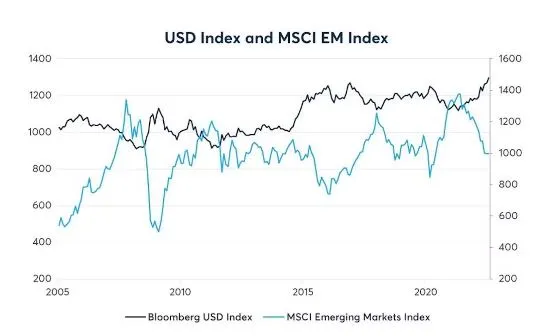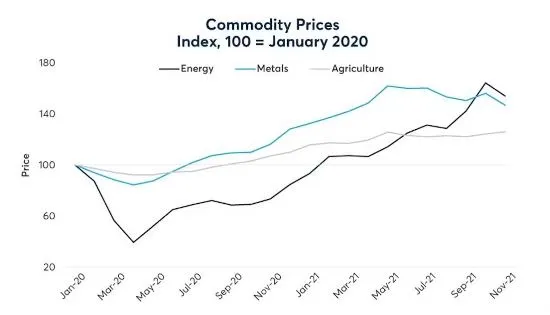The strong dollar has become a defining force in global markets, shaping economies and influencing trade dynamics worldwide. As the world’s primary “invoicing currency,” a stronger dollar directly affects international commerce and economic stability. When the dollar gains strength, other currencies weaken, creating ripple effects across economies, especially in emerging market economies. Coupled with surging commodity prices and rising inflationary pressures, this financial environment presents unprecedented challenges for global trade.
The Strong Dollar’s Impact on Global Trade Dynamics
A strong dollar increases the cost of goods priced in U.S. dollars, making imports more expensive for nations with weaker currencies. For example, countries importing raw materials like oil, copper, or agricultural products face significant cost surges. This currency imbalance discourages trade and depresses global economic activity.
Emerging economies, which depend heavily on imports and foreign investments, feel the strongest pinch. When their currencies depreciate against the strong dollar, the cost of servicing dollar-denominated debt rises dramatically. Argentina, for instance, has struggled to stabilize its economy amid soaring debt obligations tied to the U.S. currency. Such scenarios amplify exchange rate risk, complicating financial stability for these nations.
Additionally, nations like Mexico and South Africa experience dual challenges: higher import costs and fluctuating export revenues. A strengthening dollar often leads to reduced purchasing power, further limiting their ability to engage in international trade.

Emerging Market Economies Bear the Brunt of a Strong Dollar
Emerging market economies often rely on external funding, much of which is denominated in U.S. dollars. When the dollar appreciates, these economies face spiraling debt servicing costs. This pattern has been evident in Turkey, where a weaker lira against the dollar led to a debt crisis that crippled its economy.
A strong dollar also triggers capital outflows from emerging markets, as investors seek the safety of dollar-denominated assets. For instance, during the COVID-19 recovery phase, countries like India and Brazil experienced significant foreign investment withdrawals, which devalued their currencies further.
The knock-on effect of this capital flight is a reduction in foreign exchange reserves. Central banks in these economies are often forced to intervene by raising interest rates, which slows down economic growth. These interventions exacerbate inflationary pressures, creating a vicious cycle of economic strain.
Commodity Prices and Their Dual Role in Global Trade

The strong dollar has a complex relationship with commodity prices. Since most commodities are priced in dollars, a stronger dollar makes them more expensive for nations with weaker currencies. This effect is particularly challenging for economies dependent on imports of essential commodities like oil and metals.
At the same time, commodity-exporting countries can benefit from higher global prices. Nations like Brazil, Russia, and South Africa have seen revenue boosts due to elevated oil, metal, and agricultural prices. However, even for these exporters, exchange rate risk remains a significant concern. While their revenues increase, they face volatility in managing profits converted back to local currencies.
For example, South Africa’s reliance on precious metals exports links the rand’s value closely to metals prices. A strong dollar creates pricing challenges for the country, as its exports become less competitive on the global market. Similarly, Mexico, as the largest importer of U.S. corn, faces rising import bills due to the unfavorable exchange rate between the peso and the dollar.
Inflationary Pressures Add to Economic Woes
Inflationary pressures are another major consequence of a strong dollar, particularly for emerging market economies. These nations typically purchase raw materials in dollars, and a stronger dollar inflates the cost of these imports. The higher costs translate into domestic price increases, fueling inflation.
For example, during periods of dollar strength, food prices in countries like Egypt and Indonesia rise significantly. This inflation erodes the purchasing power of local consumers and heightens social and economic tensions. Central banks in these regions often respond with tighter monetary policies, such as increasing interest rates. While these measures aim to stabilize inflation, they also hinder economic growth.
The interplay of a strong dollar, rising inflation, and elevated commodity prices creates a challenging environment for policymakers. They must balance measures to manage exchange rate risk while fostering economic stability.
Managing Risks Amid a Strong Dollar
Countries and businesses employ several strategies to mitigate the effects of a strong dollar. Hedging through financial instruments like futures and options allows exporters and importers to manage exchange rate risk. For instance, China, as a major copper importer, uses futures contracts to stabilize costs despite dollar fluctuations. Similarly, Mexico leverages peso futures to manage risks associated with corn imports.
Central banks in emerging economies also intervene by deploying foreign exchange reserves to stabilize their currencies. However, this approach is not sustainable in the long term, as it depletes reserves and limits policy flexibility. Governments must focus on diversifying their economies and reducing reliance on dollar-denominated debt to weather the impacts of a strong dollar.
Conclusion
The strong dollar continues to reshape global trade and fuel economic challenges, particularly for emerging market economies. Its far-reaching effects amplify exchange rate risk, inflate commodity prices, and heighten inflationary pressures. These challenges demand proactive measures, from hedging strategies to robust economic policies. As the dollar remains a dominant force in international trade, understanding its impact is crucial for navigating the complexities of the global financial system.
Click here to read our latest article Slippage in Forex Exposed




